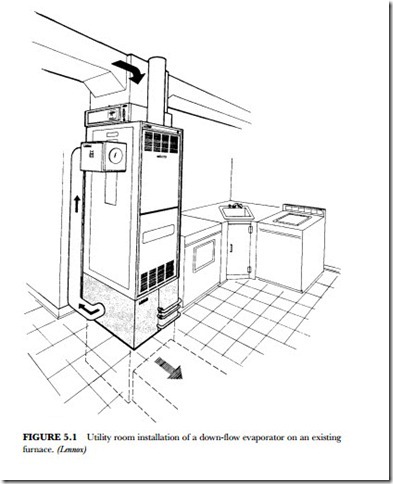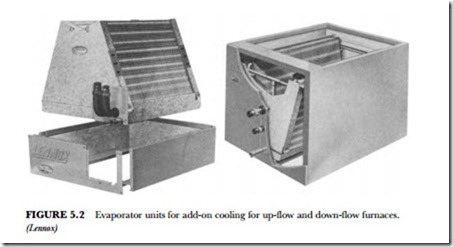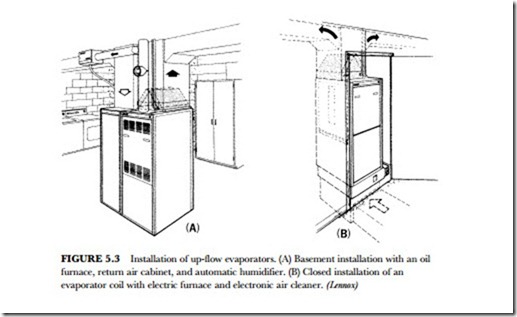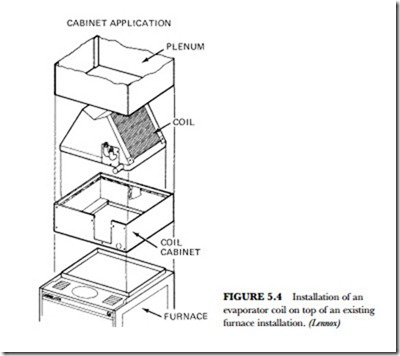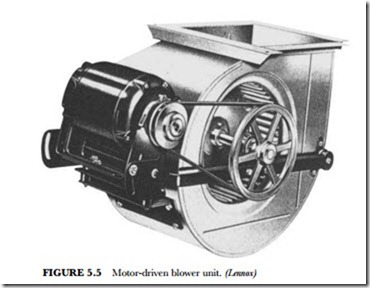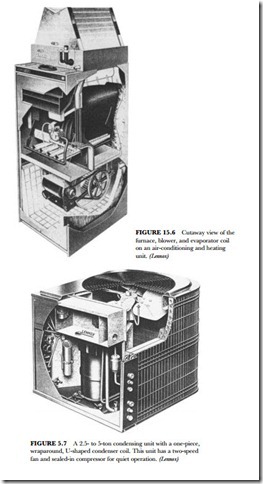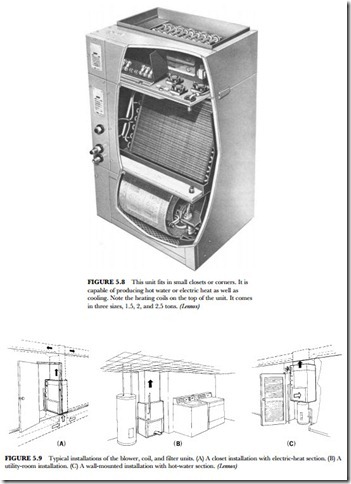DUCTWORK FOR ADD-ON RESIDENTIAL EVAPORATORS
One of the more efficient ways of adding whole-house air conditioning is with an evaporator coil in the furnace. The evaporator coil becomes an important part of the whole system, as does the ductwork. It can be added to the existing furnace to make a total air-conditioning and heating package. There are two types of evaporator, down-flow and up-flow.
The down-flow evaporator is installed beneath a down-flow furnace. (See Figure 5.1.) Lennox makes down-flow models in 3-, 4-, and 5-ton sizes with an inverted “A” coil. (See Figure 5.2.) Condensate runs down the slanted side to the drain pan. This unit can be installed in a closet or utility room wherever the furnace is located. This type of unit is shipped factory-assembled and tested.
Up-flow evaporators are installed on top of the furnace. They are used in basement and closet installations. (See Figure 5.3.) The adapter base and the coil are shown as they would fit onto the top of an up-flow existing furnace. (See Figure 5.4.) The plenum must be removed and replaced once the coil has been placed on top of the furnace.
In most cases, use of an add-on top evaporator means that the fan motor must be changed to a higher horsepower rating. The evaporator in the plenum makes it more difficult to force air through the heating system. In some cases, the pulley size on the blower and the motor must be changed to increase the cfm (cubic feet per minute) rate moving past the evaporator.
Some motors have sealed bearings. Some blower assemblies, such as the one shown in Figure 5.5, have sealed bearings; others have sleeve bearings. In such cases, the owner should know that the motor and blower must be oiled periodically to operate efficiently.
Figure 5.6 shows how the evaporator coil sits on top of the furnace, making the up-flow type of air-con- ditioning unit operate properly. The blower motor is located below the heater and plenum.
The evaporator is not useful unless it is connected to a compressor and condenser. These are usually lo- cated outside the house. Figure 5.7 shows the usual outdoor compressor and condenser unit. This unit is ca- pable of furnishing 2.5 to 5 tons of air conditioning, ranging in capacities from 27,000 to 58,000 Btu. Note that this particular unit has a U-shaped condenser coil that forms three vertical sides. The extra surface area
is designed to make the unit more efficient in heat transfer. The fan, which is thermostatically operated, has two speeds. It changes to low speed when the outside temperature is below 75 degrees F (23.9 degrees C).
Like most compressors designed for residential use, this one is hermetically sealed. The following safety devices are built in: a suction-cooled overload protector, a pressure-relief valve, and a crankcase heater. Controls include high- and low-pressure switches. They automatically shut off the unit if discharge pressure becomes excessive or suction pressure falls too low.
In apartments where space is at a premium, a different type of unit is used. It differs only in size. (See Figure 5.8.) Compact units have a blower, filter and evaporator coil contained in a small package. They have electric-heat coils on top. In some cases, hot water is used to heat in the winter.
Figure 5.9 shows the various ways in which these units may be mounted. The capacity is usually 18,000 to 28,000 Btu. Note the location of the control box. This is important since most of the maintenance problems are caused by electrical rather than refrigerant malfunctions. This type of unit allows each apartment tenant to have his or her own controls.
